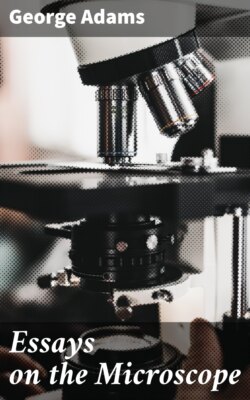Читать книгу Essays on the Microscope - George Comp Adams - Страница 32
На сайте Литреса книга снята с продажи.
LIST OF APPARATUS GENERALLY MADE TO THIS MICROSCOPE.
ОглавлениеThe wheel, with the magnifiers, P. Fig. 1.
The body of the microscope, A B.
The slider-holder, K.
The tube, with the condensing lens L, to be used by candle-light.
The pin and arm a, either for the above lens, or for the silver concave speculum e.
The silver concave speculum e, fitted to the arm above, and used common to all the magnifiers in the wheel and body A B, it is to reflect the light from the concave or plane mirror O below, upon the opake objects, then called the compound opake microscope.
A silver concave speculum f, with a single magnifier; it screws to the under part of the arm C D in room of the wheel of magnifiers, and forms then the single opake microscope.
A brass cone g, to place under the stage N I S, and serves to diminish the reflected light when necessary.
The jointed nippers b, fitted to the stage, to hold any small insect, or other opake object.
A cylinder of ivory h, to fix on the pointed end of the nippers, black on one side and white on the other, to make a contrast to the opake object used.
Six ivory sliders, i, each having four holes, and objects contained between two talcs confined together by brass circular wires. One of the sliders is usually sent without objects, to be supplied at pleasure. When used, they are placed between the perforated plates of the slider-holder K; where also is to be applied the brass frame slider k, containing in one brass piece four small concave glasses fixed; a narrow slip of glass slides over these, all within the frame; so that any very small living object, as a mite, &c., may be viewed with the proper security.
A set of glass tubes, l, three in number, to contain tadpoles, water newts, small frogs, eels, &c. which are curious objects for affording a fine view of the circulation of the blood, &c. They are also to be placed in the slider-holder K. There is a small hole at one end to admit air, the other end is to be stopped with cork, to contain the fluid and prevent the escape of the animal. A brass twisted wire is sent, to assist in the cleaning of these tubes.
A small ivory box, m, containing talcs and wires to supply the ivory sliders with, should any be lost or damaged.
A lens set in a brass cell, n, of such a focus as to view objects under a magnifying power sufficient for the applying them to the instrument for further inspection; hence it has been called the explorator. It may occasionally be screwed to the arm C D, and is then well adapted for viewing objects of the larger kind, or the whole of an insect, &c. before the observing of it in part under the regular magnifiers.
A concave, or a circular plane glass, o, for transparent objects, or animalcula in fluids, &c. it is fitted to the side, I, of the stage.
It is necessary to describe the lens and frame, d, noticed at page 95; it is either for converging the sun’s rays upon opake objects laid upon the stage, or for magnifying a flower, or other large objects applied to the stage, or on the nippers or point, b. By its pin and spring socket it is easily raised to any height, for the sun, candle, or the eye of the observer.
A brass insect box, h, consisting of a concave and plane glass that screw close together; by means of which a louse, flea, &c. may be secured, viewed alive, and retained for any time. It is applied to the hole I, of the stage, Fig. 1.
A pair of small brass forceps, q, by which any small object may be conveniently taken up or moved.
This microscope packs into a mahogany pyramidical shaped case, about seven inches square at its base, and fourteen inches in height. For its price, see the general list annexed to this work.
